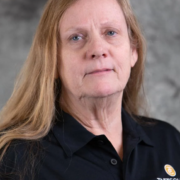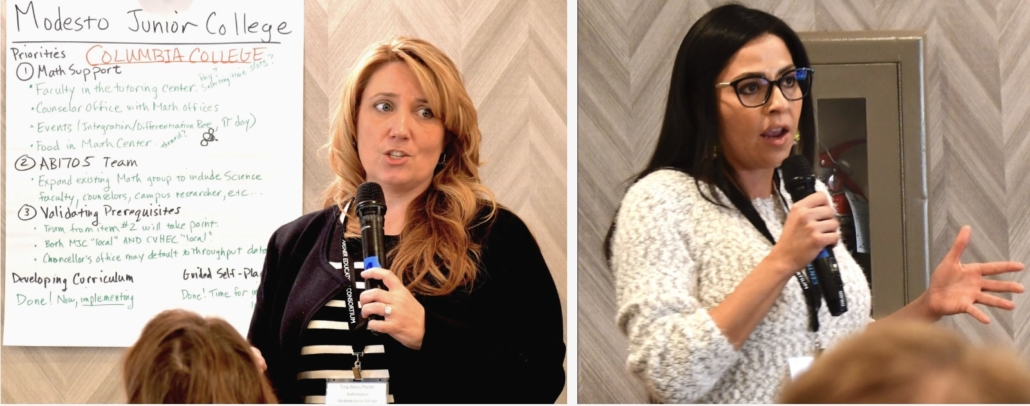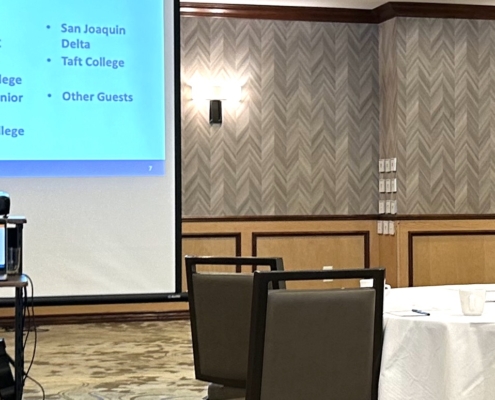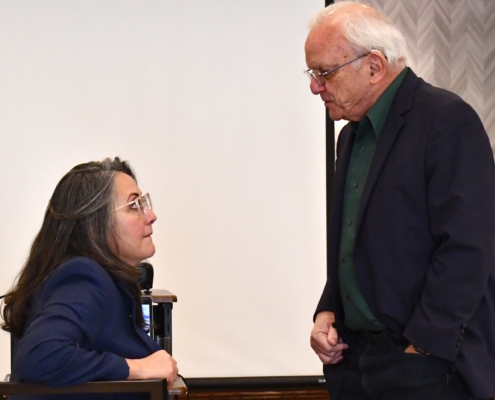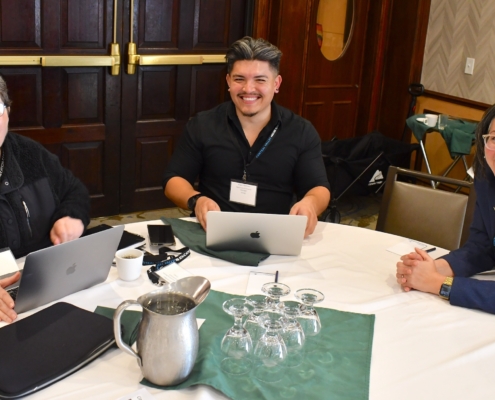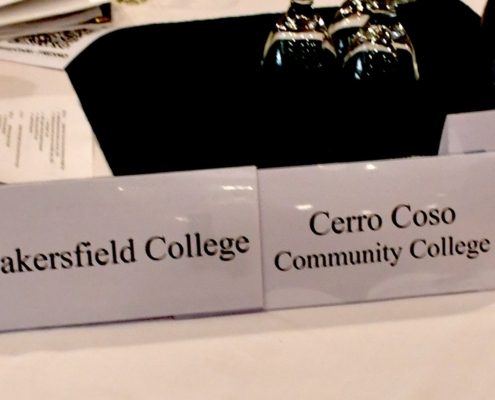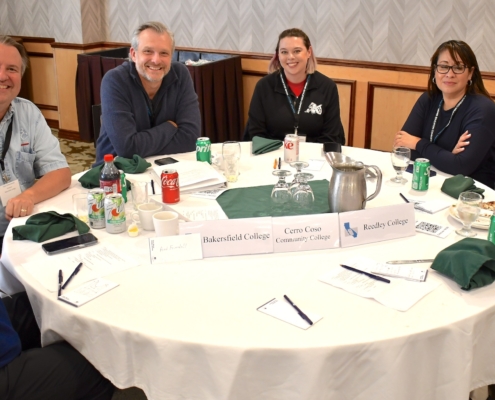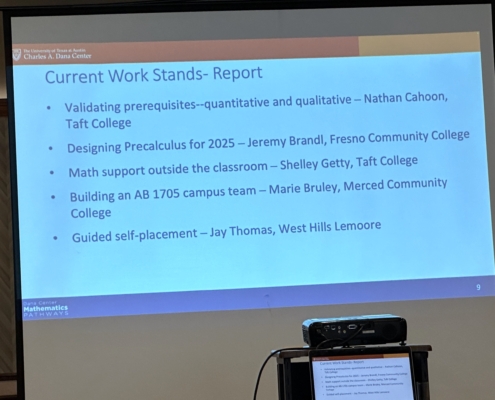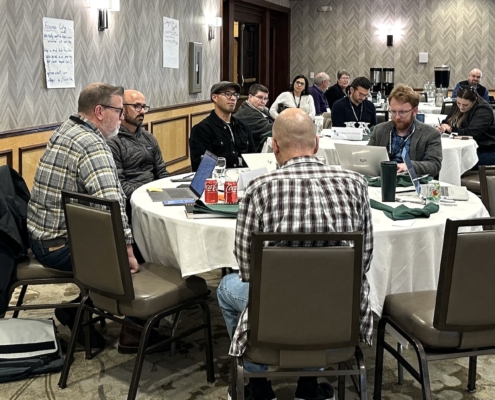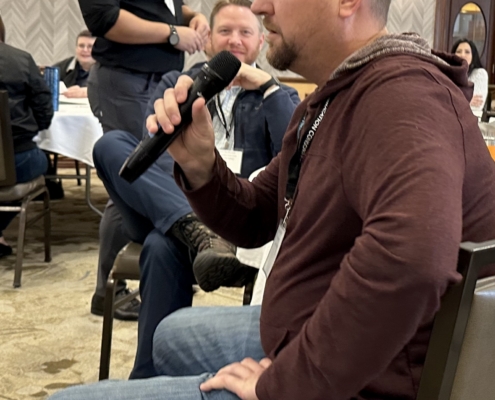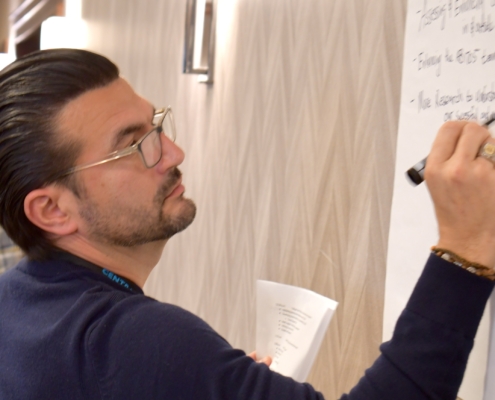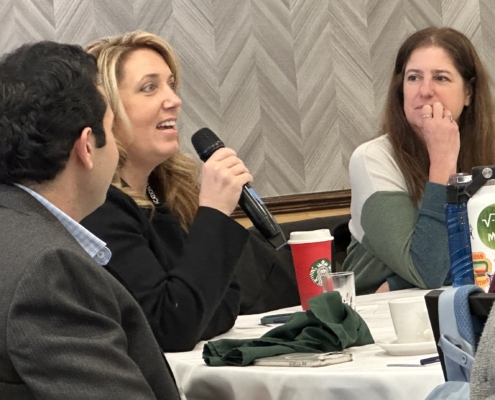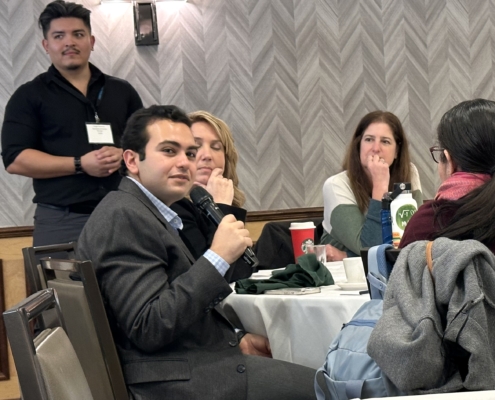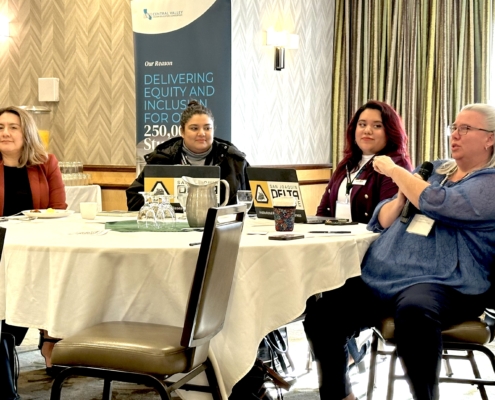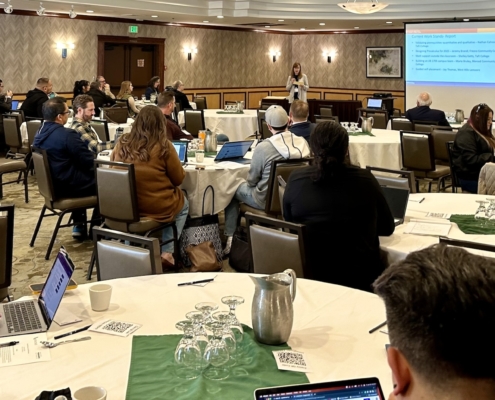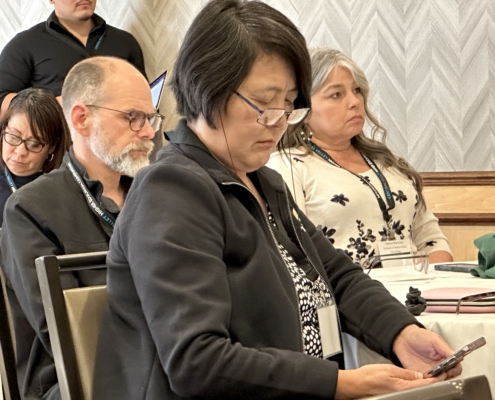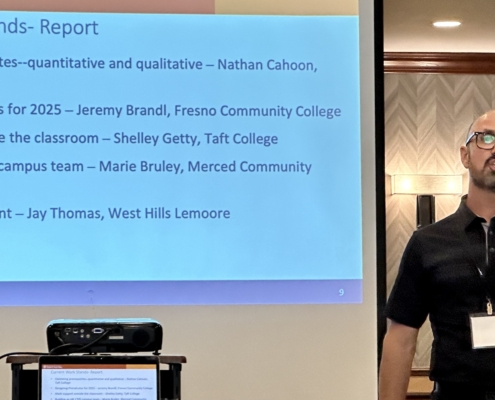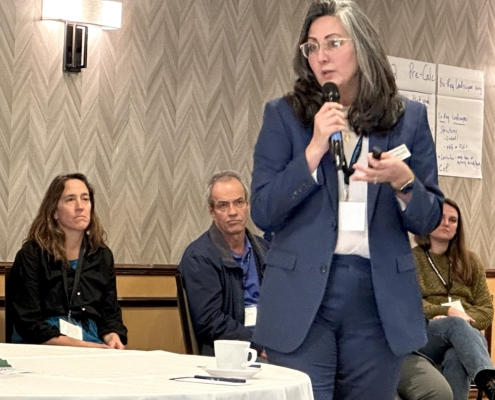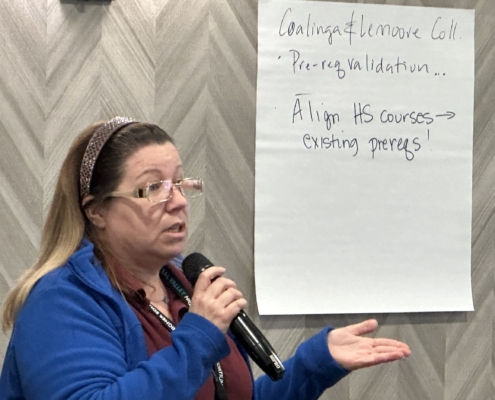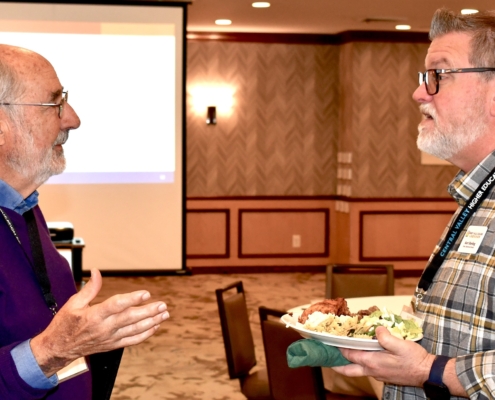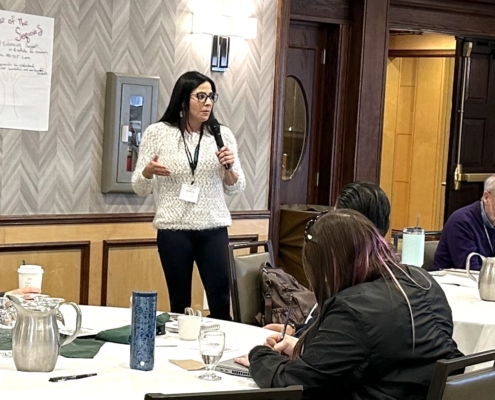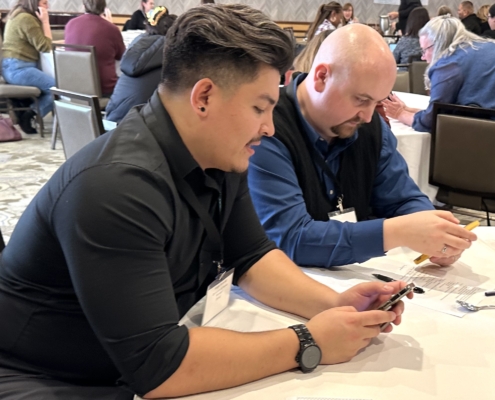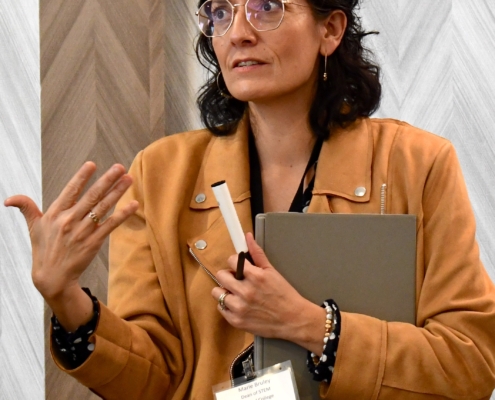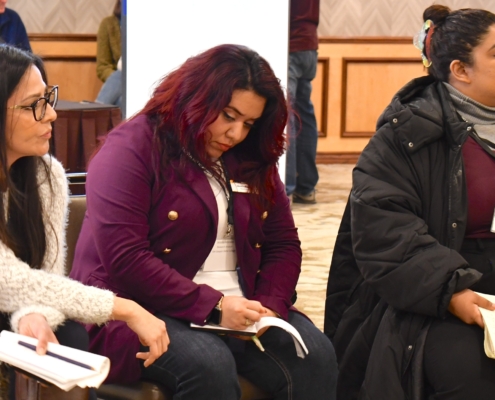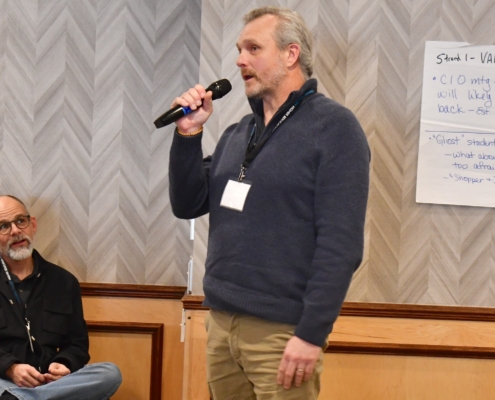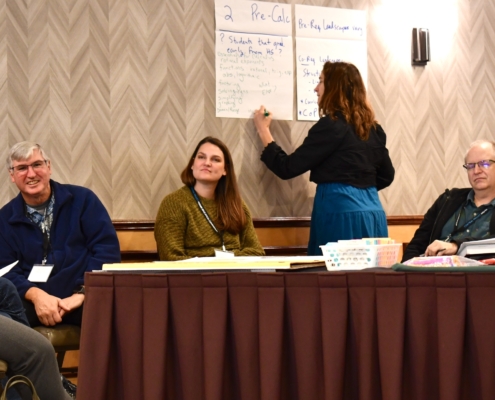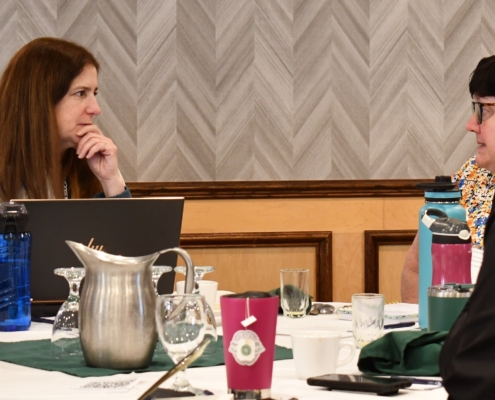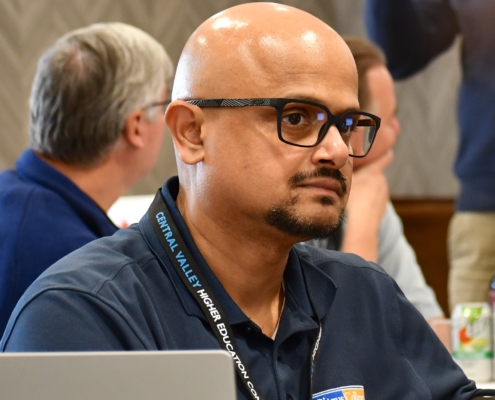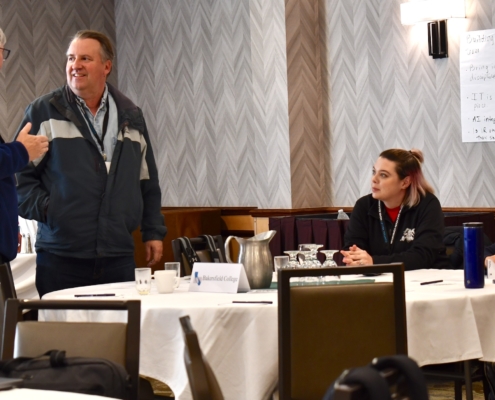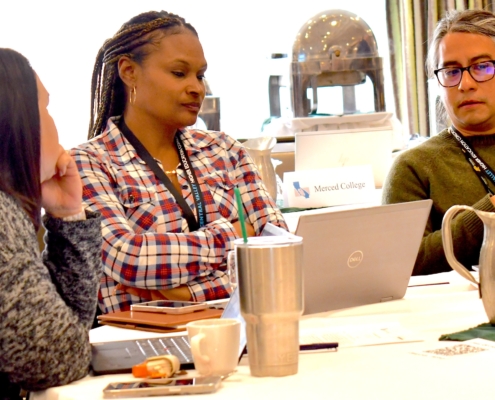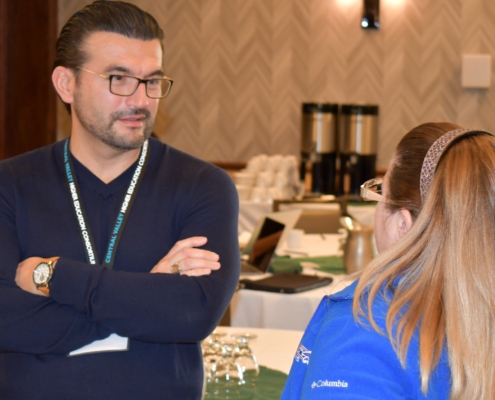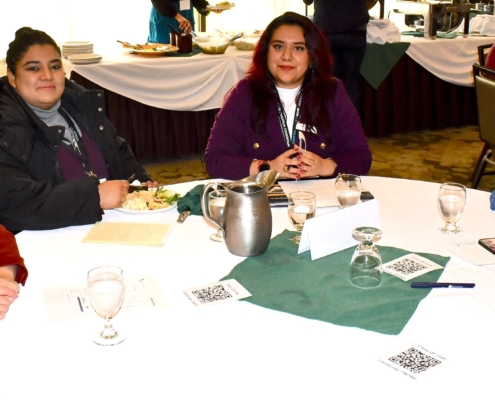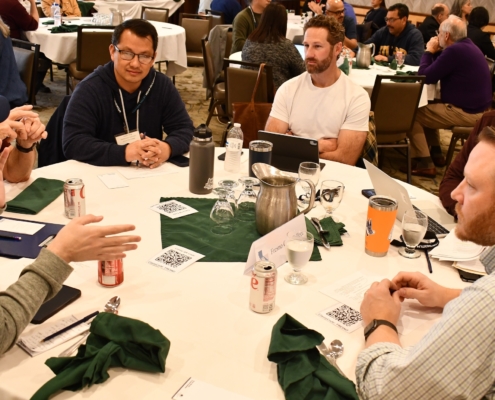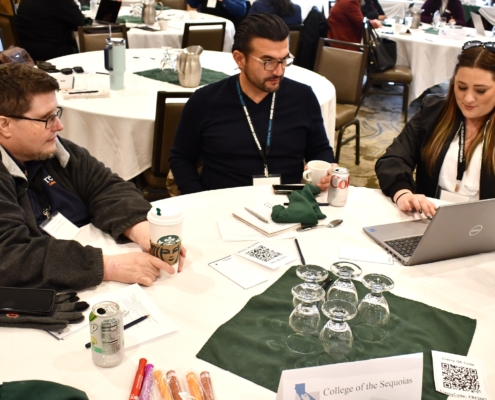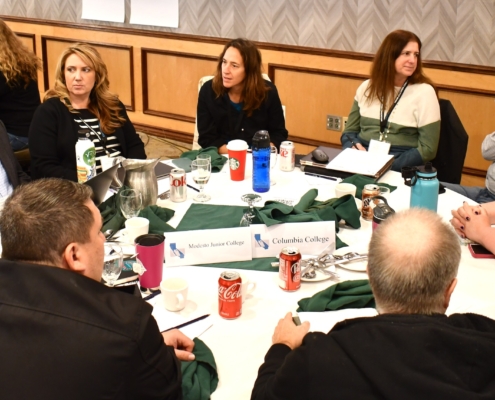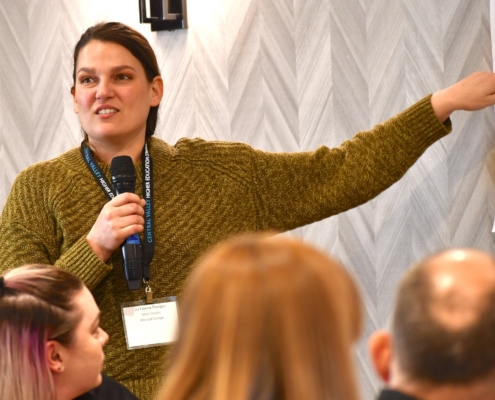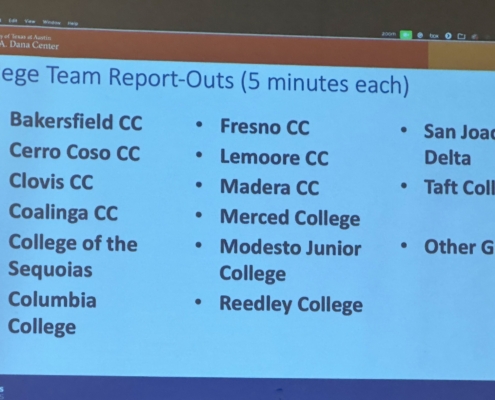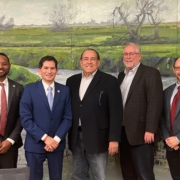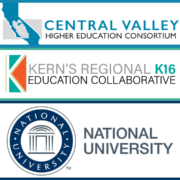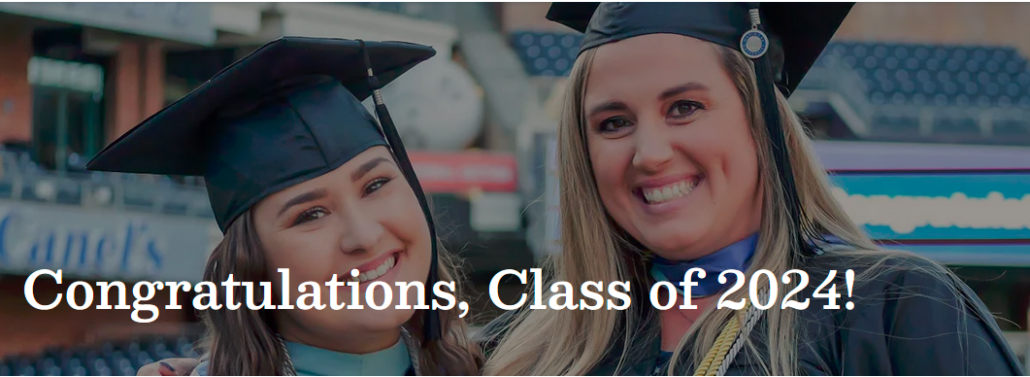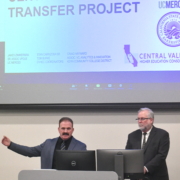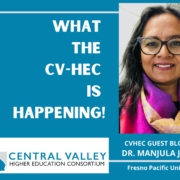MATH TASK FORCE: ‘Something extraordinary’ (Jan. 26 wrap)
Modesto Junior College math professor Tina Akers-Porter discusses her strand group’s deliberations at “The Central Valley Way to AB1705 Success” Convening Jan. 26 where a call for a “principals task force” by Orosi High School Principal Marlena Celaya would bring more secondary education voices to the table.
‘Something extraordinary is happening in math in California’s Central Valley’
Math Task Force latest AB1705 session leads to calls
for more data, high school input, re-convene April 19
BY TOM URIBES
CVHEC Media/Communications Coordinator
Realizing that state guidance surrounding Assembly Bill 1705 remains elusive, valley community college math educators and officials forged ahead at “The Central Valley Way to AB1705 Success” convening Jan. 26 in Fresno with a determined and unified mindset to develop implementation plans that will serve the best interests of their students including a follow-up session set for April.
In addition, the Central Valley Higher Education Consortium (CVHEC) Math Task Force discussion centered around five strands of curriculum planning for implementation before the law goes into effect July 1, two aspects emerged at the lively day-long work session: the increased participation of institutional researchers for pertinent data-collecting and a call for a “principal’s task force” to bring upper secondary education voices to the table.
Presented by CVHEC, the convening — the latest in a series of deliberations since fall — was attended by 82 representatives from the consortium’s 19-member community colleges, one high school principal and campus research professionals.
They agreed to reconvene April 19 for reports on follow-up work that will occur as a result of this most recent event. Registration for that event will open next month with additional details forthcoming.
Facilitated by the Charles A. Dana Center at the University of Texas at Austin, the session last month reviewed five strands of curriculum planning: Validating Prerequisites; Designing Precalculus for 2025; Math Support Outside and Inside the Classroom; Building an AB 1705 Campus Team; and Guided Self-Placement.
“With tensions high and little guidance surrounding AB1705, the 19 community colleges and districts that comprise the CVHEC nine-county region are rolling up their sleeves and getting to work on this math movement the ‘Central Valley Way’,” summarized Tammi Perez-Rice of the Dana Center.
Perez-Rice, who co-facilitated the event, said the convening was solely dedicated to working and planning at a regional and institutional level in two parts. The first part was dedicated to expanding the five work groups that emerged from the Nov. 17 webinar and creating a plan to move forward. The second half of the convening was devoted to institutional planning.
“The fruits produced from these convenings are already being felt around the region,” Perez-Rice said. “The plans and implementations emerging from these convenings are more than just a response to AB705 and AB1705; they cultivate systemic reforms that will benefit all students in the CVHEC region and beyond.”
John Spevak, CVHEC regional coordinator who oversees the consortium’s Math Task Force and co-facilitator of the Jan. 26 gathering, said in the short-term, the five strands work groups will continue to communicate and provide updates in preparation for the April 19 convening. The strand leads are preparing summaries of their Jan. 26 breakout discussions and member college teams are preparing summaries of the tentative plans they developed in the afternoon breakout sessions for oral reports in April.
“In the longer term, our Math Task Force will continue to monitor what the California Community College Chancellor’s Office says, while mainly going forward with our own Central Valley approach to the five strands.”
That “Central Valley Way” stems from the work undertaken by the CVHEC Math task Force, first formed in 2019, in the past year that was intensified with four work sessions beginning Oct. 6 in a virtual convening with CCC vice-chancellor Eric Cooper. The first in-person session followed Oct. 13 in Fresno and another virtual session was held in two parts Nov. 17 before the Jan. 26 session.
These sessions may represent the only concerted effort by a region’s community college math community actively meeting to collaborate across campus boundaries for ways to unite as one voice and determine a curriculum course of action that meets the law’s intent, Spevak said.
“We at CVHEC, along with the Dana Center representatives and our College Bridge partners in the Math Bridge Program, feel that something extraordinary is happening in math in the Central Valley of California,” Spevak said.
After the Jan. 26 session ended, Perez-Rice reiterated a point she made the first time she visited Fresno for the first in-person convening last fall:
“This collaboration today was amazing. As I travel and talk to math faculty all over the country, what I see pulsating from the CVHEC community here in Central California is just compassion; caring about their students; putting their students first; understanding what their students need; and more importantly collaborating with each other working across institutions to make things happen.”
Inviting secondary ed voices to ‘align syllabi’
A key development of the convening was the assertion and agreement that a crucial next step is “to involve high schools in the discussion and determine how to breakdown barriers between systems for a cohesive collaborative effort to put students first across the state of California,” a message delivered by Marlena Celaya, principal of Orosi High School who was the only secondary education official in attendance.
Celaya’s comments, first in a strand session and later in general comments before the assembled group, resonated with the community college professionals as she offered to lead a task force of principals/administrators who would unify with the CVHEC community college math educators for implementation strategy — to listen and hear what the needs are and how to meet those needs.
“I’m willing to lead this work because I don’t want people to go through the wars I went through teaching algebra and volunteering all my time,” said Celaya, a former math teacher at Dinuba High School. “We would want to hear from community colleges and say to them ‘what do you need?’
“We heard something from you today: ‘I want to know what courses are offered at the high school and what does that course description look like?’ Aligning syllabi is what I’d like to do,” Celaya said. “Mathematics is my passion.”
Perez-Rice said the April 19 convening promises more high school representation, with over twelve principals who are part of the Math Bridge Program by CVHEC and College Bridge being invited. Other secondary education officials from throughout the valley are welcome she said.
Participant feedback: ‘great to see we’re not alone in this …’
After the event, several participants shared their assessment of the Jan. 26 convening.
“The conversations were amazing and we really appreciated being here,” said Joshua Lewis, chair of the Bakersfield College Mathematics Dept.
“There have been so many legislative changes and so many unknowns it’s nice to see the work that other campuses are doing and realize that we’re not alone, that we have shared values; that we have shared emphasis on student learning and really care about doing right by all of our students,” he added.
Nathan Cahoon, Taft college math professor, felt that the efforts of CVHEC’s Math Task Force as exhibited at the convening is strengthening the voice of the valley’s math community which will have an impact.
“It was amazing to work with incredible professionals who have some really amazing ideas,” he said. “I know I took many good notes about ideas to implement at our college. The connections we are building here with each other will be powerful down the road as we build a cohesive effort to get some good research together that we can send to the state as one voice from all the colleges.”
Modesto Junior College math professor Marina Hernandez said coming together within the region is relished because when attending other statewide or national conferences, the focus is not as localized.
“It was very helpful to learn what other colleges in the Central Valley are doing because we share similar student population and resources characteristics and their best practices are applicable to us here in our region,” Hernandez said.
Tina Akers-Porter, Modesto Junior College math professor, said the Math Task Force work has helped her better understand what AB1705 is and what it means for her students.
“I feel like I have a better understanding of some of the challenges of the legislation and what others are worried about,” she said. “We share some of those worries but it’s great to hear different points of view on that. A byproduct of this is we are seeing how we need to support underprepared students more, inside and outside the classroom, and sharing ideas to do that.”
Shelly Getty, Taft college math faculty and a strand leader, echoed Akers-Porter: “We left knowing we are going to start some specific tutoring and targeting students for tutoring. We will try to advertise it better and recruit so students get more access to the services we already provide which will greatly impact them. We shared some good ideas on how to do that effectively.”
Marissa Martinez, Taft college math professor, said, “We have our work cut out for us. There’s a lot of things that we have to address with a lot of moving parts. Everything keeps changing but it was great to be able to see that we’re not alone in this, that we’re working together to better serve our students.”
She said this intercollegial collaboration and the feedback from the colleges helps “so we don’t have to reinvent the wheel — what worked, what didn’t work.”
Next steps? Data research
“I would say the next step is collecting our data to see how the numbers show where we are so we can prove that these courses are important for our student success,” Martinez said.
This data aspect was also a key part of the convening as institutional research professionals were invited and directly participated such as Arooj Rizvi, research analyst in the Office of Institutional research and Effectiveness at San Joaquin Delta College.
“Researchers have a monumental role in the implementation of AB 1705 because policymakers are going to depend a lot on what we are able to produce as a group or even as an institution,” Rizvi said. “Being a part of these conversations helps us to see the bigger picture, the context and the requirements of what exactly it is that we are looking for in the data.”
She said it was exciting to hear at the convening what area colleges are going through.
“I realized how similar our challenges are from institution to institution, “she said. “Working through that together and being solution-oriented is something that’s going to take all of us towards a beneficial direction. Seeing us all here today was a defining moment in history.”
Owynn Lancaster, vice president of academic strategy for CVHEC partner College Bridge, said the event was “a huge success seeing folks come together from math to talk about math and really pool their resources to address actual challenges.
“The most powerful focus of change in education is always the educator,” Lancaster said. “I know everything’s heaped on them but in a lot of ways they have the greatest power of the greatest agency for this.”
For more info: centralvalleyhec@gmail.com
For CVHEC media inquiries: Tom Uribes – cvheccommunications@mail.fresnostate.edu (or text 559.348.3278).
See also:
https://bit.ly/MTFconveneKSEE24
Valley’s math ed experts unite to address AB 1705 challenge for student success
The CVHEC Way to Math Success — Implementing AB1705
Math Task Force begins discussion of AB1705 implementation – Nov. 17 next
CVHEC Math Task Force meets in-person Oct. 13 for AB 1705 follow-up
NEWS RELEASE – CVHEC Math Task Force: Impactful legislation (AB 1705) Convenings Oct. 6 & 13
CVHEC Website Feature: Math Task Force Page
PHOTO GALLERY
Central Valley Transfer Project: valley’s four-year colleges collaborating
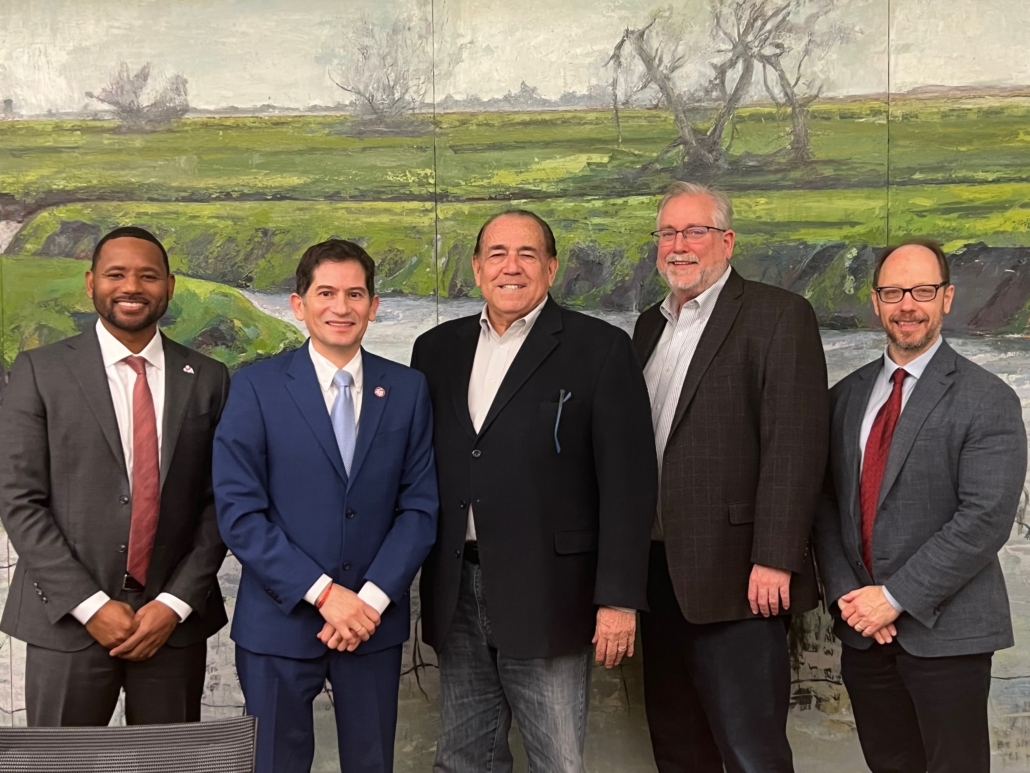
Fresno State, a founding CVHEC member, joined CVHEC’s historic Central Valley Transfer Project in January with (from left): Dr. Kent Willis, vice president of Fresno State Student Affairs and Enrollment Management; University President Saúl Jiménez-Sandoval; Dr. Benjamin Duran, CVHEC executive director; Tom Burke, CVHEC regional coordinator; and Dr. Sergio La Porta, associate dean of the Fresno State College of Arts and Humanities.
Fresno State joins in transfer ‘centerpiece’ with
11 CVHEC community colleges, 3 CSUs, UCMerced
The Central Valley Transfer Project is now partnered with the region’s three California State University campuses after Fresno State signed on in January joining Bakersfield and Stanislaus in the historic Central Valley Higher Education Consortium initiative designed to open new doors for students’ successful transfer from community college.
Along with founding partner University of California, Merced, this means the valley’s four public institutions of higher education are working in unison with 8 community colleges currently through CVHEC’s project using the groundbreaking Program Pathways Mapper software. The project has also gained the full support of the California Community College Chancellor’s Office.
The community colleges already in the CVTP, with several more expected to sign on this year, are: Bakersfield College, Clovis Community College, Madera Community College, Merced College, Porterville College, Reedley College, West Hills College-Coalinga and West Hills College-Lemoore.
The Transfer Project is also expanding participation in the north end of the Central Valley with Modesto Junior College, Columbia College and San Joaquin Delta College scheduled to begin onboard this spring for a total of 11 community college partners said Stan Carrizosa, CVHEC regional coordinator and consortium lead for the project.
All Transfer Project partners are members of the consortium with their respective chancellors and presidents serving on the CVHEC Board of Directors.
“The Transfer Project is now a centerpiece for students to both enter and transfer from community college to their four-year universities,” said Dr. Benjamín Durán, CVHEC executive director. “We are excited to share this latest progress of the project which has been featured statewide and nationally at conferences such as the Community College League of California and Complete College America.”
He added, “This innovative approach is the only one in the state that includes a University of California campus collaborating with partner California State University and community colleges in establishing transfer pathways for Central Valley students to get them to and through college in a timely manner.”
Dr. Saúl Jiménez-Sandoval, Fresno State president and CVHEC board member, said, “I’m proud that Fresno State will be a dynamic partner in the Central Valley Transfer Project, as this pathway will empower community college students to become visionary Bulldogs.”
The Fresno State agreement was finalized Jan. 17 between Durán and President Jiménez-Sandoval, with Tom Burke, CVHEC regional coordinator and Transfer Project team member; Dr. Kent Willis, vice president of Enrollment Services; and Dr. Sergio LaPorta, associate dean of the College of Arts and Humanities.
At CVHEC’s Higher Education Summit last fall, CCC Chancellor Sonya Christian announced that the statewide system has designated the Transfer Project as a demonstration project as set forth in her Vision 2030 for all California community colleges. The Transfer Project’s participating community colleges are serving as the pilot campuses with plans to implement statewide.
Carrizosa said the state budget continues to support and fund the onboarding costs for all community colleges to subscribe to the Program Pathways Mapper.
Established in 2021 with UC Merced, Merced College and Bakersfield College, the project is designed to open new doors for students to successfully transfer from community college with its Program Pathways Mapper, Carrizosa said.
He said the Program Pathways Mapper — a public facing, internet-based app that can be downloaded and accessed by the public software platform — provides unprecedented ease of access for students, counselors, advisors and parents much more so than other existing platforms.
“There are no typical requirements for access to PPM such as other internal college systems like Degree Works, Assist.Org and the CSU Transfer Planner,” he said. “These are all course tracking systems but in order to use them, students need to be successfully enrolled in college and have a student email address or other form of login to try and plan. Through PPM students simply upload the public PPM app to their devices and have immediate access.”
Carrizosa said the PPM helps simplify the transfer planning process which can be the most difficult task for many students.
“In much of our Central Valley region, as many as seven out of 10 incoming college freshmen will be first generation students to attend college,” he said. “Research shows that the most difficult task for them is often the application process itself and completing the required steps for enrollment. Systems like Degree Works and others do nothing to remove this common barrier because these systems cannot be accessed until a student successfully enrolls.”
He explained that a high school student can start the Transfer Project journey as a junior or senior by enrolling in college dual enrollment courses enabling them to complete their transfer level English and Math courses while still in high school. These units roll up with them as they enter community college and track the completion of their lower division requirements for their Associate Degree for Transfer in their chosen major via PPM.
“Students can easily select a community college they wish to attend and a major they want to pursue and the lower division courses required are sequentially laid out for them through the Program Pathways Mapper software.”
In addition, the PPM then links those lower division courses to an upper division institution of the student’s choice and shows a clear sequence of upper division courses needed to complete the degree, Carrizosa added.
“The PPM contains clear and accurate information directly from course catalogues from all participating colleges,” Carrizosa said. “The Central Valley Transfer Project is becoming an alternative continuum of courses to the traditional high school A-G or Career Technical Education continuums and is unprecedented in the state’s community college system. We call it ‘The Central Valley Way!’”
“Through the use of PPM, students complete exactly what is required of them to successfully transfer to their four-year university and they follow PPM through their last two years to degree/certificate completion,” Carrizosa said.
Baseline data results also demonstrate the promise that PPM delivers in the Transfer Project.
In a sample of 5,000 incoming freshmen to Bakersfield College in 2022 the students using the PPM increased their “percentage of on-path course completion” to over 80 percent which also closed the equity gap in this statistic for ethnic minority students when compared to their white counterparts, Carrizosa said.
“The same sample showed students using the PPM reduced the ‘number of units-to-degree’ from an average of 87 down to 67,” he added.
The project is now gearing up to expand the partnership with the College Bridge Math Project and to onboard community colleges from the northern region of the Central Valley.
For more information about the CVTP, contact Carrizosa at centralvalleyhec@gmail.com.
CVHEC media inquiries: Tom Uribes – cvheccommunications@mail.fresnostate.edu or text 559.348.3278.
Fresno State media inquiries: PIO Lisa Bell – lbell@csufresno.edu.
See:
· Pilot CVHEC/UC Merced Transfer Project improves process for students
· CVHEC Web Site Feature: Transfer Project
· Historic Transfer Project spurs statewide movement to increase transfer rates
· HIGHER ED NEWS: College Bridge to expand Math Bridge; CVHEC Transfer Project
• A-G
Kern Master’s Upskilling Program: 2nd cohort graduates – next cohort recruitment underway
Two cohorts from the Kern Master’s Upskilling Program (MA English) are eligible to participate and walk in the 2024 National University Commencement May 18 at Petco Park in San Diego. The program’s high school teacher participants are now qualified to teach English dual enrollment community college courses on their respective campuses. A third English cohort and the first Kern math cohort graduate in June.
Kern Master’s Upskilling Program
reaches another milestone
Second English cohort graduation – recruitment underway for a fall math cohort
The Kern Master’s Upskilling Program for high school teachers seeking a master’s degree in English or Math that qualifies them to teach dual enrollment courses at their respective campuses reached its second milestone last month when 11 participants completed post-baccalaureate requirements in English through National University.
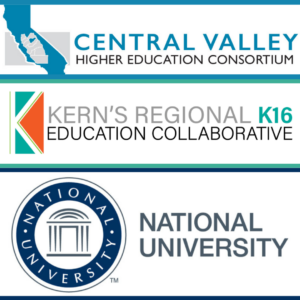 Formally known as the Dual Enrollment Teacher Upskilling Pathway for English and Mathematics, the Central Valley Higher Education Consortium initiative is in partnership with the Kern Regional K-16 Education Collaborative that was funded as part of an $18 million statewide competitive grant in June 2022 to improve student progress from high school to postsecondary education and ultimately into the workforce.
Formally known as the Dual Enrollment Teacher Upskilling Pathway for English and Mathematics, the Central Valley Higher Education Consortium initiative is in partnership with the Kern Regional K-16 Education Collaborative that was funded as part of an $18 million statewide competitive grant in June 2022 to improve student progress from high school to postsecondary education and ultimately into the workforce.
The program also announced recruitment is underway for a third math cohort of 21 students to begin this fall for completion in spring 2026 though Fresno Pacific University in concert with the Kern County Superintendent of Schools (KCSOS), which serves as the administrative agent for the Kern K-16 Collaborative.
Informational meetings are set for March 21 and April 11 at 4:30 p.m.
A potential fourth English cohort pilot through CSU, Bakersfield with seven students is also in the works said Tom Burke, CVHEC’s Kern Masters Upskilling Program lead who reports that the program progress “has been very good” since it was funded two years ago.
“With the first two cohorts of English graduates to be joined by our first cohort of math graduates this summer, we are well on the way to significantly increasing the number of faculty in Kern County eligible to teach dual enrollment or community college courses in math and English,” Burke said.
The January graduation follows the first cohort of 11 English students who graduated in September for the innovative state-funded CVHEC initiative that helps reduce the cost of tuition for high school teachers to pursue a master’s degree, a state requirement to teach community college dual enrollment courses.
Each NU cohort group of students is eligible to participate and walk in the 2024 Commencement services set for Saturday, May 18, at Petco Park in San Diego, said Jessica Gladney, senior director for Partnership Development/ Workforce Education Solutions for National University,
The first Kern Master’s Upskilling Program cohort — MA, English with a specialization in Rhetoric — began in January 2023 with 13 out of 15 students completing their program in November 2023 (nine of the 13 will graduate with honors with a grade point average of 3.85 and above).
The two remaining students are currently in the process of completing their capstone, which is the culminating course of the master’s program, Gladney said.
The second Kern Master’s Upskilling Program cohort of MA, English with a specialization in Rhetoric, began in March 2023, and 10 out of 15 students completed their program in January 2024. The remaining students are currently in the process of completing their capstone course, Gladney reports.
She said each NU cohort group of students is eligible to participate and walk in the 2024 Commencement services set for Saturday, May 18, at Petco Park in San Diego.
“We are proud of these candidates and we are excited to assist with building a qualified candidate pool of eligible dual-enrollment English teachers to meet the workforce demands in the Central Valley,” Gladney said.
CVHEC, made up of 28 institutions of higher education in the valley’s nine-county region from San Joaquin to Kern counties, is one of several partners in the Kern Collaborative.
South Valley CVHEC members include California State University, Bakersfield; Kern Community College District; Bakersfield College; Cerro Coso College; Taft College; Porterville College; Fresno Pacific University; and National University.
The project also includes the CVHEC Mentor Program that pairs the master’s candidates with a community college mentor to support them along the way and help them navigate the process to becoming an adjunct community college faculty member.
Under coordinators Dr. Liz Rozell (math) and Dr. Vikash Lakhani (English), the program is still accepting community college professors to serve as mentors, Burke said.
For more details about the fall 2024 math cohort through Fresno Pacific, potential students can contact:
- Manjula Joseph, program director – manjula.joseph@fresno.edu or 559.453.2096
- Nathan Lyness, senior Outreach & Admissions representative – nathan.lyness@fresno.edu or 559.453.7183
See:
- CVHEC Teacher Upskilling Program for Master’s Degrees Supports Dual Enrollment in South Valley via Kern K-16 Collaborative Grant (June 23, 2022)
- Rozell, Lakhani Named CVHEC’s Kern Faculty Mentor Coordinators (February 22, 2023)
- CVHEC IN THE NEWS: KBAK features Kern Master’s Upskill Program (November 17, 2022)
- Tom Burke Named Kern Master’s Upskill Lead (November 16, 2022)
- Herrera to Head Kern Regional K-16 Education Collaborative (July 13, 2022)
- KCSOS Mary Barlow Announces $18.1M Workforce Grant (KCSOS press release – June 9, 2022)
- “Blurring the Lines Between High School and College: Dual Enrollment in the Central Valley”(CVHEC video – March 2022)
Historic Transfer Project spurs statewide movement to increase transfer rates
CVHEC Summit Oct. 20 features Central Valley Transfer Project/Mapper update
BY STAN CARRISOZA, CVHEC Regional Coordinator
President-emeritus – College of the Sequoias
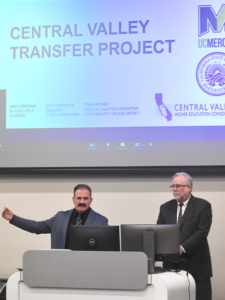
At left, CVHEC Regional Coordinators Stan Carrisoza and Tom Burke present the Transfer Project (Burke is now serving as interim chancellor of the Kern Community College District).
As we enter the third phase of the Central Valley Transfer Project, we are pleased to report great progress has been made ranging from its infancy two years ago to nationwide interest — including possible expansion into another region of California in the near future — as our team is invited regularly to present at state and national conferences.
A presentation and update will be given at the upcoming Central Valley Higher Education Consortium’s 2023 Summit Oct. 20 in Fresno, as well as at conferences in November and December.
Originally born out of dissatisfaction with Central Valley community college transfer rates to University of California, Merced, this effort has spurred a statewide movement at multiple levels to increase the number of successful community college transfers to four-year institutions.
The state budget allowed CVHEC to help the community colleges secure state funding to purchase ongoing access to the software element of the project known as Program Pathways Mapper (PPM).
Recent reporting regarding the California State University and the UC Board of Regents has energized efforts to increase community college transfers and mobilize around successful transfer strategies.
Successful strategies are the foundation of the CVHEC Transfer Project. We have codified simple, straightforward activities for CC and CSU/UC faculty to convene and collaborate to map accessible transfer pathways in numerous discipline majors. In a breakthrough effort by UC Merced, its faculty agreed to review and build on the already successful CSU transfer patterns approved in the Associate Degree for Transfer (ADTs).
Following the pilot project in 2021 with UC Merced, Bakersfield College and Merced College, the CVHEC/UC Merced Transfer project has grown to include several more CVHEC colleges including Porterville, Reedley, Madera, West Hills Coalinga, West Hills Lemoore, Modesto, San Joaquin Delta, Yosemite and Columbia. The project has also included Central Valley four-year institutions CSU Bakersfield and CSU Stanislaus.
Over the past year the project has piqued the interest of the Aspen Institute, the Public Policy Institute of California, the Chief Student Services Officers Association, College Futures Foundation and Complete College America.
Interviews and conferences with these organizations have brought broad exposure to the project and this fall CVHEC will initiate the SoCal Transfer Project being planned to emanate from the North Orange County Community College District. These plans include NOCCCD colleges Fullerton and Cypress to engage with UC Merced, UC Irvine and CSU Fullerton.
As previously reported, early results from the first 5,000 incoming freshmen at Bakersfield College in 2022 shows a strong positive impact from the Transfer Project.
At the core of the project is the Program Pathways Mapper software platform. The ease of access for students, counselors, advisors, HS counselors and parents has proven to be the key factor in success versus other degree auditing software systems.
Among those first 5,000 freshmen tracked, students using the PPM vs. their counterparts not using PPM eliminated the achievement gap among underrepresented students in their On-Path Percentage of courses successfully completed. This significantly reduced their number of units to degree.
We invite interested colleagues and partners to join us in this movement to increase successful transfers by attending our scheduled presentations this fall and winter. In addition to our summit in Fresno later this month, you will find CVHEC’s Transfer team sharing the project at the annual Community College League of California Conference in November and at the Complete College America Conference in December.
For more information: contact Stan Carrizosa at scarrizosa44@gmail.com or visit the Central Valley Transfer Project page on the CVHEC website.
See our full list of Transfer Project stories: Central Valley Transfer Project Archives
See the Central Valley Transfer Project page.
WHAT THE CV-HEC IS HAPPENING GUEST BLOG (April 2023): Kern Math Master’s Upskilling/Dr. Manjula Joseph
 With the first cohorts of the Kern Master’s Upskilling Program underway, this guest blog is by Dr. Manjula Joseph, associate professor and program director for math education at Fresno Pacific University, a CVHEC member institution. She reflects on the experiences of the math cohort offered by FPU with 21 current practicing high school teachers enrolled in the program designed to empower them to create classrooms that foster a love for math with specific sights set on eventually teaching dual enrollment courses at their respective high schools. This first Kern math cohort completes in July 2024. (An English master’s cohort offered by CVHEC member National University is also currently in session).
With the first cohorts of the Kern Master’s Upskilling Program underway, this guest blog is by Dr. Manjula Joseph, associate professor and program director for math education at Fresno Pacific University, a CVHEC member institution. She reflects on the experiences of the math cohort offered by FPU with 21 current practicing high school teachers enrolled in the program designed to empower them to create classrooms that foster a love for math with specific sights set on eventually teaching dual enrollment courses at their respective high schools. This first Kern math cohort completes in July 2024. (An English master’s cohort offered by CVHEC member National University is also currently in session).
Transforming Practicing Teachers into Innovative Math Educators
Embracing the shift in math education for the Kern Master’s Upskilling Program: Fresno Pacific University’s MA in Mathematics Education
By Dr. Manjula Joseph
Program Director, Math Education – Fresno Pacific University
I enter the (zoom) room and observe a class in session.
The students in the first cohort of our Kern Master’s Upskilling Program for practicing high school math teachers are sharing celebrations and challenges about life events – school, family, health, etc. Some of them request prayer.
After this brief time of sharing, they are presented with a graph of an intertwined circle and parabola with a red-shaded area and asked to respond to the prompts “What do you notice? What do you wonder?” on a Google Jamboard. Their two-dozen responses range from noticing symmetry to wondering what the center of the circle might be. Then, moving to breakout rooms to discuss how they might solve the problem at hand, they write their thoughts on the Jamboard.
The complex problem involves differential and integral calculus, trigonometry and intricate algebraic manipulation. Not initially finding answers only seems to push them further to learn unfamiliar concepts, expand prior knowledge and reach a solution.
Professor Alice Keeler, the instructor, and I silently observe this activity unfold and marvel. What I have just observed firsthand is a genuine “community of learners” engaged in supporting and strengthening each other’s content and pedagogical knowledge.
Student Kim Halbrook also observes: “The program is designed to build ‘a community of educators’ willing to support and help each other be the best teachers they can be.”
So, what makes FPU’s program unique?
In a rapidly evolving educational landscape, our Master of Mathematics Education program at Fresno Pacific University (FPU) stands out as a beacon for change.
Focused on a humanized, student-centered approach, we transform practicing teachers into innovative math educators who embrace the shift from traditional instruction towards a more engaging and holistic learning experience without compromising rigor.
Propelling the Shift in Humanizing Mathematics
We see mathematics as a deeply humanizing activity emphasizing critical thinking, problem-solving and collaboration — a fundamental shift from viewing it as cold and abstract, and emphasizing speed and competition.
Mathematics affords us the space to explore the mysteries of the universe and appreciate the beauty and order that underlies it. Mathematics also allows us to think logically and critically about the challenges and inequities that plague society, empowering us to contribute to the advancement of human knowledge, social justice and progress.
Our program helps teachers embrace this shift, enabling them to foster a love for mathematics, a joy for exploration and a passion for problem-solving in their own classrooms.
“Fresno Pacific University has provided more content-specific advancements in my career as an educator than the entirety of my Teacher Preparation Program,” says student Brandon Butler.
Believing Engagement is More Than Just Fun
Our program recognizes that engagement is not synonymous with fun. We believe that true engagement comes from feeling rewarded for one’s efforts and that students would rather work on challenging tasks (absorption) than boring, easy tasks (compliance).
We prioritize student engagement through personal connections, using collaborative tools and interactive activities. Our approach models compassion and grace, encouraging teachers to create classroom environments where mathematics is seen as a means for thinking and engaging, rather than as a competition.
Student Edna Cruz affirms: “I have learned so much about integrating technology in a way that encourages students to think and engage in productive struggle. All this in a course that unites a group of people who genuinely love math and the advancement of education, to better serve the students of our community. We are all taking what we are learning and implementing it in our own classrooms.”
Balancing Commitment with Life
Our program acknowledges the challenges faced by teachers who must balance their commitment to earning a master’s degree with their existing teaching responsibilities and family life.
With this in mind, we designed a student-centered program that cares for students not just as learners but as individuals with unique personal and professional lives. This philosophy influences assignments, discussions, and interactions. We view students (both ours and their students in turn) as whole persons, cultivating an environment where teachers can develop their skills while maintaining a strong connection to their own values and personal lives.
A Passion for Reimagining Math Education
In conclusion, the Master of Mathematics Education program at Fresno Pacific University offers a transformative experience for practicing teachers passionate about reimagining math education.
Focusing on humanizing mathematics, emphasizing human-centered approaches, and embracing a balanced approach, our program empowers teachers to create classrooms that foster the love for mathematics and nurture the critical thinking skills necessary to be successful in finding solutions to the challenges of today and tomorrow.
Presenting our renovated CVHEC Website: Meet our Board of Directors
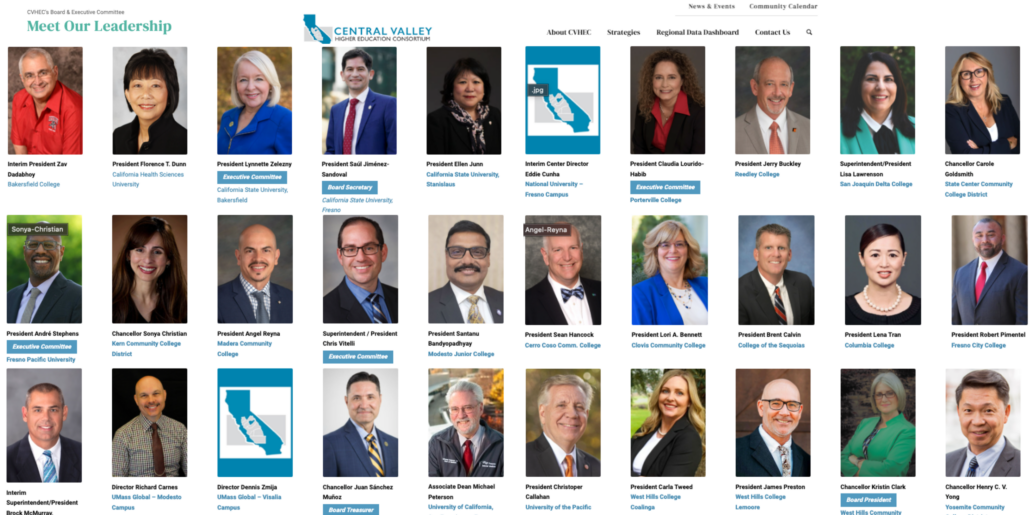
The chancellors, presidents and superintendents of 30 institutions of higher education in the Central Valley nine-county region from Stockton to Bakersfield sit on the CVHEC Board of Directors. They meet quarterly in pursuit of CVHEC’s core mission to increase valley college-going rates and degree/certification attainment, providing a unified voice for their more than 250,000 students served jointly. See the board of directors section in our newly renovated website: https://cvhec.org/about-cvhec/
This fall, we unveil phase one of our renovated Central Valley Higher Education Consortium website which we hope will be easier to navigate as we showcase the work of the Consortium throughout the valley.
We will be featuring a different piece of our website as we continue to build it out in hopes of showcasing it as a resource for our members, colleagues and partners.
This month, we feature the professionals and experts who are carrying out the CVHEC mission. On the “About CVHEC” page, you can meet our CVHEC Board of Directors – the presidents and chancellors of our 30 members of higher education in the Central Valley’s nine-county region from Stockton to Bakersfield as well as the core staff that includes several former educational leaders who now served as CVHEC regional coordinators/liasions,
Also, see our CVHEC News web page that is being finalized this fall featuring our newsletter stories and press releases where news media can connect with us as well as the members of our CVHEC PIO/Communicators Committee, consisting of the communications professionals handling media relations at each of the 30 campuses.
Our new calendar will keep you up-to-date on CVHEC and other higher education events on our radar. For considerations and modifications to our calendar please email centralvalleyhec@gmail.com.
CVHEC Member News: CLP Guidance Pathways
Four CVHEC Members Highlighted in Career Ladders Project
Look at Guided Pathways Redesign Challenges
The Career Ladders Project recently highlighted four CVHEC member organizations in stories illustrating how 15 California community colleges are redesigning their Guided Pathways programs and structures prompting college leaders across the state to share the stories to help clarify opportunities, spur conversation and motivate Guided Pathways redesign teams.
Founded by the California Community Colleges Board of Governors in 2002, Career Ladders Project is a nonprofit that operates under the fiscal sponsorship of the Foundation for California Community Colleges.
The project promotes equity-minded community college redesign by collaborating with colleges and their partners to discover, develop, and disseminate effective practices. CLP policy work, research, and direct efforts with colleges lead to system change—and enable more students to attain certificates, degrees, transfers, and career advancement.
The Guided Pathways stories are presented in one-page narratives — grouped into topics — produced by Career Ladders Project with funding from the California Community Colleges Chancellor’s Office.
The four CVHEC members highlighted are:
Bakersfield College
• Integrating Student Supports in Guided Pathways Redesign
• Aligning Redesign Across Campus
• Using Data in Guided Pathways Redesign
Madera Community College
• Centering Students in GP Design
West Hills College Lemoore
• Aligning Redesign Across Campus
• Supporting Students from a Distance
Reedley College
Managing Guided Pathways redesign and Engaging the College
See the CLP Redesign stories overview.
CVHEC BLOG: ‘WHAT THE CV-HEC IS HAPPENING’ (Dec. 2021)
[vc_row][vc_column][vc_column_text]The opening panel discussion at the CVHEC/UC Merced Transfer Project convening Nov. 4 in Merced included Shirley Asher, Jennifer Johnson, Karissa Morehouse, Sonya Christian, Gregg Camfield and Chenoa Woods.
The beat – serving student success – goes on!
An inside look at the CVHEC/UC Merced Transfer Pathways Initiative and Mapper
By Tom Burke
CVHEC Transfer Project Coordinator
(Photo Gallery below)
In June, when I stepped down as chancellor of the Kern Community College District, many thought I would embark on the typical “retirement” life of fishing, hunting, traveling and just resting after a 40-year career.
 While I did enjoy some of that, I also soon found myself right back in the saddle in a “new” role with KCCD as Deputy Chancellor and as a coordinator with the Central Valley Higher Education Consortium. So for those of you wondering: no I’m not officially “retired!”
While I did enjoy some of that, I also soon found myself right back in the saddle in a “new” role with KCCD as Deputy Chancellor and as a coordinator with the Central Valley Higher Education Consortium. So for those of you wondering: no I’m not officially “retired!”
Rather I am happy to report that the past few months have been quite a rewarding whirlwind as I plunged headlong into a new “assignment” as coordinator of CVHEC’s Transfer Project with the intent to enhance what has been my life’s work: serving students in general and in this case specifically, helping build effective pathways to our community colleges for a smoother, efficient transfer experience.
To that end, these past 45 days alone have seen the fruition of two great milestones.
First was the public celebration of the completion of Phase I of a joint program, the CVHEC/UC Merced Transfer Pathways Initiative, at a convening Nov. 4 on the UCM campus with community college partners Bakersfield and Merced Colleges. Secondly, at that historic event, we also launched Phase II of this project that includes the participation of four more CVHEC member institutions: Porterville College, Reedley College, Clovis College and West Hills College-Lemoore.
Revolutionizing Positive Outcomes
The Transfer Pathways Initiative is the result of a $500,000 grant from the California Educational Learning Lab to Bakersfield College, Merced College and UC Merced for the development of 2+2 transfer maps that streamline and guide the transfer of community college students to the University of California system.
Last month’s convening, “Charting Better Maps to Degrees – Developing Transfer Pathways to UC Merced,” demonstrated how we can revolutionize positive outcomes across enrollment, completions and equity for students while emphasizing UC Merced’s commitment to significantly expanding transfer pathways for community college students within the San Joaquin Valley to UC Merced.
With about 172 participants representing all three segments of higher education, the hybrid convening itself was a hallmark of sorts being the first major gathering convened by CVHEC and its partners since the pandemic shut down the world in March 2020. The energy from seeing and hearing our colleagues in the flesh was very evident throughout the six-hour event that was also presented virtually via Zoom (130 virtual and 42 in person).
CVHEC member community colleges were well represented at the convening where we discussed how in Phase 1, our partner teams completed 14 Transfer Pathways from Merced College and Bakersfield College to UC Merced as well as Transfer Pathway work with California State University, Bakersfield.
The convening also further introduced interested colleges to the Pathway Mapper software program, particularly its ability to enhance the student transfer experience as well as early student success results from institutions utilizing the Pathway Mapper. Participants also received information on future Program Mapper software enhancements that are scheduled.
The topics of four breakout sessions portrayed the breadth and depth of our mission:
- The Tech Behind Program Pathways Mapper
- Student Impact of Program Pathways Mapper – On-path Percentage, Student Engagement
- Getting Started with Program Pathways Mapper: Cleaning and Loading Your Curriculum
- The Technology of Collaboration – How to set up effective intersegmental discipline faculty teams and develop 2+2 transfer Documentation of process and guidelines.
Implementation teams of faculty, staff working hand-in-hand
The second great milestone is the launch of Phase II which actually got its start in the summer when a convening of representatives from all 15 CVHEC community colleges included an update presentation on the aforementioned Phase I completion of the 14 Transfer Pathways from Merced and Bakersfield Colleges to UC Merced.
At that June 16 convening, significant interest was expressed for participation in Phase II project implementation so in the early fall CVHEC reached out to interested member community colleges with a call to form and submit their implementation teams.
The four Phase II community colleges mentioned above — Porterville, Reedley, Clovis and West Hills-Lemoore — established teams and scheduled convenings to commence the development of curriculum transfer pathways to UC Merced. They will now be individually convening in the next four months with the first held Dec. 2-3 at Porterville College.
That recent convening was my first as a coordinator and I was impressed with the commitment and excitement by the Porterville College, faculty, staff and administrators to develop nine transfer pathways directly to UC Merced including a new pathway in Spanish.
Perhaps the pinnacle of that enthusiasm was to observe, when a potential curriculum issue arose, how UC Merced staff collaborated and interfaced with community college faculty and staff for solutions on the spot. They collectively brainstormed and developed options for resolving the issue.
In particular, the level of commitment by host Porterville College to fulfill this mission for their students was further demonstrated by the active involvement and attendance in the two-day convening by the Vice President of Instruction Thad Russell, Vice President of Student Services Primavera Arvizu and President of the Academic Senate Robert Simpkins. In addition, Porterville College President Dr. Claudia Habib made an appearance at the convening impressing upon faculty and staff the importance of their contributions to this project for their students’ success and thanked them for their work on the pathways.
Equally, I was impressed with the Transfer Project planning team, especially CVHEC colleague Stan Carrizosa, a former College of Sequoias superintendent/president, and James Zimmerman, senior associate vice provost and dean for Undergraduate Education at UC Merced.
We hope this level of partnership by all parties will be emulated by all our members, which I am convinced will only lead to a great reward: positive outcomes across enrollment, completions and equity for students.
And that will clearly make for happier fishing, hunting and traveling days along the way (when I can squeeze them in)!
Happy Holidays to all!
See UC Merced press release: https://news.ucmerced.edu/news/2021/uc-merced-offer-simpler-transfer-pathway-central-valley-community-college-students
See Merced Sun Star story: UC Merced announces partnership to encourage Valley community college student transfers

Dr. Benjamín Durán, CVHEC executive director; Dr. Sonya Christian, Kern Community College District chancellor; Lark Park, director of the California Education Learning Lab; and Dr. Juan Sánchez Muñoz, UC Merced chancellor.
[/vc_column_text][/vc_column][/vc_row][vc_row][vc_column][vc_images_carousel images=”6150,6118,6120,6119,6184,6171,6164,6162,6161,6147,6148,6149,6151,6144,6142,6141,6096,6140,6107,6170,6139,6138,6136,6135,6121,6122,6126,6127,6130,6131,6132,6133,6110,6109,6108,6143,6059″ img_size=”large” autoplay=”yes” title=”Gallery: CVHEC/UC Merced Transfer Pathways Initiative — UC Merced campus Nov. 4″][/vc_column][/vc_row]
MEMBER NEWS: CCO honors 8 CVHEC members with ‘Champions’ Awards
Campaign for College Opportunity honors
8 CVHEC members with ‘Champions’ Awards
Eight CVHEC member institutions were honored as 2021 Champions of Higher Education and Equity Champions for Excellence in Transfer by the Campaign for College Opportunity.
Honored at CCO’s annual Champions of Higher Education for Excellence in Transfer virtual awards ceremony Nov. 16 were Bakersfield College; Clovis Community College; California State University, Bakersfield; College of the Sequoias; Fresno City College; Fresno State; Modesto Junior College; and Reedley College.
These colleges and universities are leading the state in: conferring the Associate Degree for Transfer (ADT); enrolling ADT earners on guaranteed pathways to a bachelor’s degree; and intentionally working to support Latinx and Black students on their path to a degree, said Michele Siqueiros, CCO president.
For a breakdown of specific awards, see the CCO announcement and video.
(CVHEC members are encouraged to submit items for this column: centralvalleyhec@gmail.com).

